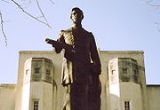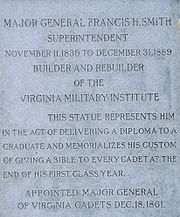
Francis Henney Smith
Encyclopedia

United States Military Academy
The United States Military Academy at West Point is a four-year coeducational federal service academy located at West Point, New York. The academy sits on scenic high ground overlooking the Hudson River, north of New York City...
graduate, United States Army
United States Army
The United States Army is the main branch of the United States Armed Forces responsible for land-based military operations. It is the largest and oldest established branch of the U.S. military, and is one of seven U.S. uniformed services...
second lieutenant, college professor, including teacher at West Point
United States Military Academy
The United States Military Academy at West Point is a four-year coeducational federal service academy located at West Point, New York. The academy sits on scenic high ground overlooking the Hudson River, north of New York City...
, Confederate Army colonel, Virginia Militia
Virginia Militia
The Virginia militia is an armed force composed of all citizens of the Commonwealth of Virginia capable of bearing arms. The Virginia militia was established in 1607 as part of the British militia system. Militia service in Virginia was compulsory for all free males...
general, first superintendent of Virginia Military Institute
Virginia Military Institute
The Virginia Military Institute , located in Lexington, Virginia, is the oldest state-supported military college and one of six senior military colleges in the United States. Unlike any other military college in the United States—and in keeping with its founding principles—all VMI students are...
(VMI) and its rebuilder after the American Civil War
American Civil War
The American Civil War was a civil war fought in the United States of America. In response to the election of Abraham Lincoln as President of the United States, 11 southern slave states declared their secession from the United States and formed the Confederate States of America ; the other 25...
and noted mathematician.
Biography

Norfolk, Virginia
Norfolk is an independent city in the Commonwealth of Virginia in the United States. With a population of 242,803 as of the 2010 Census, it is Virginia's second-largest city behind neighboring Virginia Beach....
on October 18, 1812 and died in Lexington, Virginia
Lexington, Virginia
Lexington is an independent city within the confines of Rockbridge County in the Commonwealth of Virginia. The population was 7,042 in 2010. Lexington is about 55 minutes east of the West Virginia border and is about 50 miles north of Roanoke, Virginia. It was first settled in 1777.It is home to...
on March 21, 1890. He married Miss Sarah Henderson who was born on January 6, 1812 on June 9, 1835 at West Point, New York
New York
New York is a state in the Northeastern region of the United States. It is the nation's third most populous state. New York is bordered by New Jersey and Pennsylvania to the south, and by Connecticut, Massachusetts and Vermont to the east...
. They had seven children.
Francis H. Smith was a graduate of the United States Military Academy
United States Military Academy
The United States Military Academy at West Point is a four-year coeducational federal service academy located at West Point, New York. The academy sits on scenic high ground overlooking the Hudson River, north of New York City...
, Class of 1833 and served as a second lieutenant in the United States Army
United States Army
The United States Army is the main branch of the United States Armed Forces responsible for land-based military operations. It is the largest and oldest established branch of the U.S. military, and is one of seven U.S. uniformed services...
until he resigned his commission on May 1, 1836. Thereafter, he was a professor of mathematics at Hampden-Sydney Institute
Hampden-Sydney College
Hampden–Sydney College is a liberal arts college for men located in Hampden Sydney, Virginia, United States. Founded in 1775, Hampden–Sydney is the oldest private charter college in the Southern U.S., the last college founded before the American Revolution, and one of only three four-year,...
from 1836 to 1839.
"Old Specs" as he was affectionately called by cadets, Smith had a long career as a mathematician and a military man. He was the first Superintendent of the Virginia Military Institute
Virginia Military Institute
The Virginia Military Institute , located in Lexington, Virginia, is the oldest state-supported military college and one of six senior military colleges in the United States. Unlike any other military college in the United States—and in keeping with its founding principles—all VMI students are...
(VMI), serving from 1839 to 1889: building it up before the Civil War and rebuilding it after its near-total destruction during that war. Some time before the Civil War, he was appointed colonel in the Virginia Militia.
At the outbreak of the Civil War, Smith was appointed a Brevet
Brevet (military)
In many of the world's military establishments, brevet referred to a warrant authorizing a commissioned officer to hold a higher rank temporarily, but usually without receiving the pay of that higher rank except when actually serving in that role. An officer so promoted may be referred to as being...
Brigadier General in the Virginia Militia on April 24, 1861, then a colonel in the 9th Virginia Infantry Regiment on July 7, 1861. He was often absent and returned to VMI when it reopened in late 1861. He was dropped as colonel of the 9th Virginia Infantry Regiment in the reorganization of May 8, 1862 and then was Colonel of the VMI Infantry battalion between April 30, 1862 and May 18, 1862, May 11, 1864 and June 27, 1864 and March 1865 and April 1865. At some date not shown in the references, possibly coincident with his appointment as "major general of cadets," he was appointed a major general in the Virginia Militia. He was appointed "major general of cadets" on December 18, 1861 according to the inscription below his statue shown in the accompanying image. Regardless whether the date of that appointment coincided with the date of his appointment as major general in the Virginia Militia, his appointments in the Confederate Army were only to positions with the rank of colonel.
Major General John C. Breckinridge
John C. Breckinridge
John Cabell Breckinridge was an American lawyer and politician. He served as a U.S. Representative and U.S. Senator from Kentucky and was the 14th Vice President of the United States , to date the youngest vice president in U.S...
was commanding Confederate forces in the Department of Southwest Virginia during a critical time in the 1864 campaign in the Shenandoah Valley. Although he did not want to use the VMI cadets in battle, Breckinridge requested that Smith send them to reinforce his outnumbered army when Union forces began to move into the valley. On May 12, 1864, Smith sent almost the entire Corps of Cadets of VMI, leaving behind only 27 cadets to guard the Institute, to help hold off the advance of the Union Army
Union Army
The Union Army was the land force that fought for the Union during the American Civil War. It was also known as the Federal Army, the U.S. Army, the Northern Army and the National Army...
under Major General
Major general (United States)
In the United States Army, United States Marine Corps, and United States Air Force, major general is a two-star general-officer rank, with the pay grade of O-8. Major general ranks above brigadier general and below lieutenant general...
Franz Sigel
Franz Sigel
Franz Sigel was a German military officer, revolutionist and immigrant to the United States who was a teacher, newspaperman, politician, and served as a Union major general in the American Civil War.-Early life:...
from the northern end of the valley. Smith, who was ill, also stayed behind. The cadets were led by 24-year old Commandant of Cadets and VMI teacher Scott Ship. On May 15, 1864, the VMI Cadets earned distinction and fame at the Battle of New Market
Battle of New Market
The Battle of New Market was a battle fought on May 15, 1864, in Virginia during Valley Campaigns of 1864 in the American Civil War. Cadets from the Virginia Military Institute fought alongside the Confederate Army and forced Union General Franz Sigel and his army out of the Shenandoah...
as the only Corps of Cadets in United States history to fight as a unit in battle. Ten cadets were killed and forty-seven were wounded in their valiant defense of the center of the Confederate line at a critical point in the battle. The Union forces were defeated and Sigel withdrew them to Mount Jackson
Mount Jackson
Mount Jackson can refer to:*A mountain summit in Antarctica:**Mount Jackson *Australia**Mount Jackson, Western Australia*One of ten mountain summits in the United States:**Mount Jackson...
and then to his headquarters at Cedar Creek
Cedar Creek
-In Delaware:*Cedar Creek, Delaware*Cedar Creek Hundred, an unincorporated subdivision of Sussex County, Delaware-In Georgia:*Cedar Creek , former name for Vickery Creek, a tributary of the Chattahoochee River-In Indiana:...
, Virginia.
Francis Henney Smith was the author of An Elementary Treatise on Algebra (1858) and co-author of The American Statistical Arithmetic, Designed for Academies and Schools (1845), Best Methods of Conducting Common Schools (1849) and College Reform (1850) and translator of An Elementary Treatise on Analytical Geometry (1860). Smith is also known as Sigma Nu International Fraternity's spiritual founder.
Francis H. Smith is buried in Stonewall Jackson Cemetery in Lexington, Virginia. His correspondence is retained by VMI.

